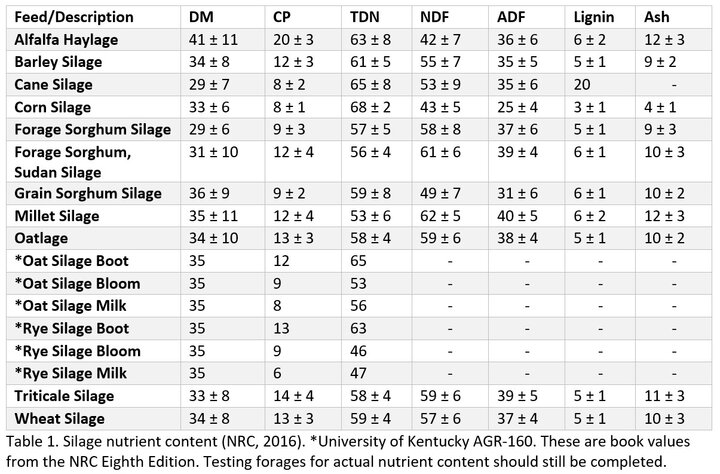When the term silage is used, typically what comes to mind is corn silage. This is especially true in the Great Plains and Midwest where corn is king. Another silage that may be less known is small grain silage.
Many producers have started using cover crops which are often small grains such as wheat, triticale, barley, oats, or the seemingly most common, rye. There are many reasons why producers may seed small grains. Some producers use small grains after corn silage to cover the bare soil, collect incentive payments from government agencies after a cash crop is harvested, have grazable feed, hay, silage, or a combination of these and more.
Grazing small grains in the spring for a short time before planting corn, soybeans, or other cash crops is very common, but many are cut for hay or ensiled for stored livestock feed. There are many forages that are used for silage that can work in conjunction with cash crops. Table 1. Shows several options and comparisons.
Make sure when making small grain silage with a cash crop that compliance with crop insurance is maintained. Contact your crop insurance agent to make sure the practices don’t eliminate your eligibility for federal crop insurance if it is utilized in an operation.
Small grain silage can result in high quality feed and have good animal performance if put up correctly which usually means at head emergence or earlier. Waiting until late milk stage to soft dough stage is often the crossover between quality and yield and still produces a high quality feed. At this point, a higher energy:protein occurs due to conversion of sugars to starch in the grain portion of the plant. As with all forages, the longer cutting is delayed, yield increases while the quality decreases. Therefore, identifying the stage of maturity is absolutely critical. The key for any nutrient value, as in Table 1., is that it varies greatly. The Table 1. values are an average of many samples and can vary greatly depending on how it was put up. Maturity is arguably the largest determining factor in forage quality and Table 1. does not specify maturity is most cases. Test the forage! A producer should not only use book values but should test to know exactly the quality of the feed. Everyone has their own spin or idea on maturity or quality of their silage or forage. Knowing exactly will pay dividends later.

While more inputs will likely be needed when double or triple cropping, producing small grain silage can increase annual production off the same acres. Small grain silage such as triticale can work great in a rotation of corn silage, then triticale silage, followed by later planted soybeans. Three crops, 2 years. As with all agronomic decisions, there are situations when tradeoffs occur. High quality feed may be a more important goal than producing a subsequent cash crop with a higher yield because the cash crop was planted later.
The ensiling process is simply a fermentation of forages and the creating of a suitable environment for anaerobic bacteria to consume carbohydrates from the sugars and starches present in the forages.
The stage of maturity to chop is the arguably most important decision and it depends on the species of small grain, the crops or forages that will be planted afterwards and the class of livestock to be fed.
Some of the keys to small grain silage are correct moisture content, proper length of cut, rapid bag/bunker/pit fill, a dense pack, and coverage of the exposed areas.
- Moisture content of the small grain forage should be from 60-70% or approximately 30-40% dry matter (DM) when making good silage. Cutting and wilting for several to 24 hours is sometimes the best option to reach that preferred 35% DM and it will reduce seepage from a direct cut unless cut at a later date when the quality is declining.
- Proper chop length will allow the fibers to interweave and pack more densely, eliminating oxygen from the pack. A 3/8 inch to 1/2 inch cut is needed for adequate packing. The hollow stem in small grains causes the need for this size of cut.
- Whether you put the silage in a bag or in a bunker, a tight pack is critical. Arguments can be made that the most important people on the silage crew are the packers and would rather have another tractor to pack than another silage truck.
- Covering the silage will reduce spoilage from oxygen, sunlight, and added moisture. Spoilage can be higher than 10%, possibly 20-25% if proper care is not taken.
Another option to consider is adding bacterial inoculants to silage. Inoculants enhance the fermentation of sugars to acid in the bag or bunker. They reduce silage pH and improve DM recovery.
Feeding the silage once fully fermented is the next step that will ensure a better feed going into livestock. When feeding off a silage face, for example, rake down only what is needed for a day’s feeding and avoid taking big chucks out of the pile. Try to keep a smooth face. When feeding out of bags, it can be easier to dilute the exposed face depending on how much is fed due to the physical limitations of how wide a bag is formed.
As with all decisions, it’s a balance and should meet the goals of a specific operation. Whatever the decision, make sure it fits your operation and you have the ability to feed the silage as part of a ration for any class of livestock. Small grain silage can be a high quality feed all the way to a low quality roughage. These options can be applied to many operations today.
Interviews with the authors of BeefWatch newsletter articles become available throughout the month of publication and are accessible at https://go.unl.edu/podcast.

